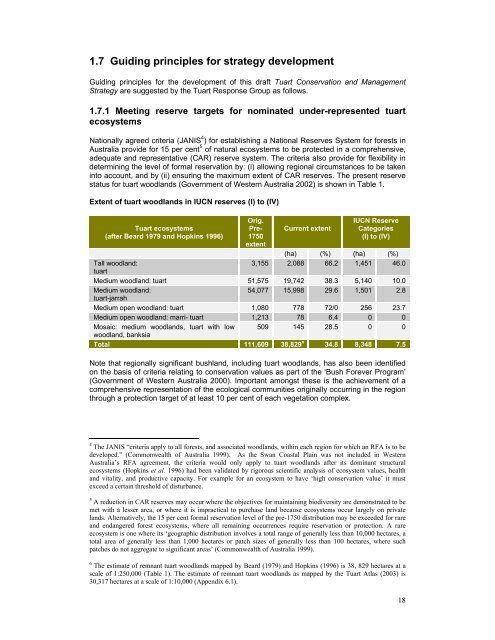DRAFT Tuart Conservation and Management Strategy
DRAFT Tuart Conservation and Management Strategy
DRAFT Tuart Conservation and Management Strategy
You also want an ePaper? Increase the reach of your titles
YUMPU automatically turns print PDFs into web optimized ePapers that Google loves.
1.7 Guiding principles for strategy development<br />
Guiding principles for the development of this draft <strong>Tuart</strong> <strong>Conservation</strong> <strong>and</strong> <strong>Management</strong><br />
<strong>Strategy</strong> are suggested by the <strong>Tuart</strong> Response Group as follows.<br />
1.7.1 Meeting reserve targets for nominated under-represented tuart<br />
ecosystems<br />
Nationally agreed criteria (JANIS 4 ) for establishing a National Reserves System for forests in<br />
Australia provide for 15 per cent 5 of natural ecosystems to be protected in a comprehensive,<br />
adequate <strong>and</strong> representative (CAR) reserve system. The criteria also provide for flexibility in<br />
determining the level of formal reservation by: (i) allowing regional circumstances to be taken<br />
into account, <strong>and</strong> by (ii) ensuring the maximum extent of CAR reserves. The present reserve<br />
status for tuart woodl<strong>and</strong>s (Government of Western Australia 2002) is shown in Table 1.<br />
Extent of tuart woodl<strong>and</strong>s in IUCN reserves (I) to (IV)<br />
<strong>Tuart</strong> ecosystems<br />
(after Beard 1979 <strong>and</strong> Hopkins 1996)<br />
Tall woodl<strong>and</strong>:<br />
tuart<br />
Orig.<br />
Pre-<br />
1750<br />
extent<br />
Current extent<br />
IUCN Reserve<br />
Categories<br />
(I) to (IV)<br />
(ha) (%) (ha) (%)<br />
3,155 2,088 66.2 1,451 46.0<br />
Medium woodl<strong>and</strong>: tuart 51,575 19,742 38.3 5,140 10.0<br />
Medium woodl<strong>and</strong>:<br />
54,077 15,998 29.6 1,501 2.8<br />
tuart-jarrah<br />
Medium open woodl<strong>and</strong>: tuart 1,080 778 72/0 256 23.7<br />
Medium open woodl<strong>and</strong>: marri- tuart 1,213 78 6.4 0 0<br />
Mosaic: medium woodl<strong>and</strong>s, tuart with low 509 145 28.5 0 0<br />
woodl<strong>and</strong>, banksia<br />
Total 111,609 38,829 6 34.8 8,348 7.5<br />
Note that regionally significant bushl<strong>and</strong>, including tuart woodl<strong>and</strong>s, has also been identified<br />
on the basis of criteria relating to conservation values as part of the ‘Bush Forever Program’<br />
(Government of Western Australia 2000). Important amongst these is the achievement of a<br />
comprehensive representation of the ecological communities originally occurring in the region<br />
through a protection target of at least 10 per cent of each vegetation complex.<br />
4 The JANIS “criteria apply to all forests, <strong>and</strong> associated woodl<strong>and</strong>s, within each region for which an RFA is to be<br />
developed." (Commonwealth of Australia 1999). As the Swan Coastal Plain was not included in Western<br />
Australia’s RFA agreement, the criteria would only apply to tuart woodl<strong>and</strong>s after its dominant structural<br />
ecosystems (Hopkins et al. 1996) had been validated by rigorous scientific analysis of ecosystem values, health<br />
<strong>and</strong> vitality, <strong>and</strong> productive capacity. For example for an ecosystem to have ‘high conservation value’ it must<br />
exceed a certain threshold of disturbance.<br />
5 A reduction in CAR reserves may occur where the objectives for maintaining biodiversity are demonstrated to be<br />
met with a lesser area, or where it is impractical to purchase l<strong>and</strong> because ecosystems occur largely on private<br />
l<strong>and</strong>s. Alternatively, the 15 per cent formal reservation level of the pre-1750 distribution may be exceeded for rare<br />
<strong>and</strong> endangered forest ecosystems, where all remaining occurrences require reservation or protection. A rare<br />
ecosystem is one where its ‘geographic distribution involves a total range of generally less than 10,000 hectares, a<br />
total area of generally less than 1,000 hectares or patch sizes of generally less than 100 hectares, where such<br />
patches do not aggregate to significant areas’ (Commonwealth of Australia 1999).<br />
6 The estimate of remnant tuart woodl<strong>and</strong>s mapped by Beard (1979) <strong>and</strong> Hopkins (1996) is 38, 829 hectares at a<br />
scale of 1:250,000 (Table 1). The estimate of remnant tuart woodl<strong>and</strong>s as mapped by the <strong>Tuart</strong> Atlas (2003) is<br />
30,317 hectares at a scale of 1:10,000 (Appendix 6.1).<br />
18

















